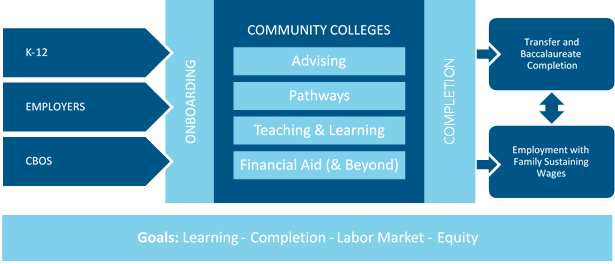Learning Objectives & Outcomes
After completing this module, participants will be able to:
- Describe the historical and contemporary evolution of the goals of community colleges.
- Examine the Aspen Institute’s definition of student success as equity, labor market learning, and completion outcomes, and articulate the rationale for this definition.
- Analyze institutional and community demographic and outcomes data to identify critical gaps, opportunities, or unmet needs.
- Define a strategic vision for student success at their community college based on the above gap analysis.
Module Overview
In recent years, community colleges have been called upon to improve student outcomes, and many sitting community college presidents and other leaders today embrace the concept of prioritizing student success. When they consider student success, most of these leaders focus on increasing degree and certificate completion rates. But many also recognize the limitations of using completion as the only outcome goal.
For this reason, new definitions of student success are emerging that combine a focus on graduation rates with other student outcome goals. Concerns about maintaining broad access for traditionally underserved populations are reflected in enrollment, retention, and graduation goals for students of color or those from low-income backgrounds. Conversations about what happens to students after they graduate have led some community colleges to track transfer and bachelor’s degree attainment as well as employment and earning rates among students who have completed. In short, “student success” is not a self-defining term (although we sometimes act as though it is). To advance student outcomes, community college leaders need to develop a strong understanding of what student success means to them and how they can assess institutional progress against that definition.
This module provides a foundation for defining community college excellence in terms of student success. One of the most important roles for a community college president is to ensure that an institution embraces and works consistently toward a clear vision that includes successful student outcomes. The readings and activities in this module offer participants an opportunity to reflect upon and begin developing that vision, and to consider how to build urgency around a strategic vision and goals.
Preparation
Prereading
- Aspen Institute, College Excellence Program. (2011). The Aspen Prize for Community College Excellence. Retrieved from https://www.aspeninstitute.org/publications/aspen-prize-community-college-excellence/
- Aspen Institute, College Excellence Program. (2015). The 2015 Aspen Prize for Community College Excellence. Retrieved from https://www.aspeninstitute.org/publications/2015-aspen-prize-community-college-excellence-2/
- Wyner, J. S. (2014). Introduction. In What excellent community colleges do. Cambridge, MA: Harvard Education Press.
- NOVA Strategic Vision 2015: Gateway to the America Dream
Prework
- Participants should locate and bring a copy of their college’s mission statement, vision statement, and strategic plan.
- Participants should complete the module data templates (found in the “Resource” section below) to the best of their ability at their institutions. Make clear to participants that they may not find all of the data, or they might find some data in different formats, from different years, or with slightly different data definitions—that is okay! The goal is for participants to have access to a common body of data. Emphasize that these data will not be collected or shared with anyone outside of the group; rather, these templates will provide participants with the information they need to begin forming a strategic vision.
Module Outline
- Kick Off Activity
- Evolving Definitions of Student Success
- Key Learning
- Group Discussion: Cases for Going Beyond Completion
- Defining and Articulating a New Vision of Student Success
- Key Learning
- Group Application Activity: Articulating a Rationale for New Definitions of Student Success
- Group Application Activity: Identifying the Key Actors
- Analyzing Data to Define a Strategic Leadership Vision for Student Success
- Warm-Up Discussion
- Inquiry Activity: Strategic Leadership Vision
- Key Learning
- Individual Application Activity: Creating a Strategic Leadership Vision
- Group Application Activity: Hypotheses for a Strategic Leadership Vision
- On-Campus Activity: Verifying the Hypothesis and Writing a Strategic Leadership Vision

